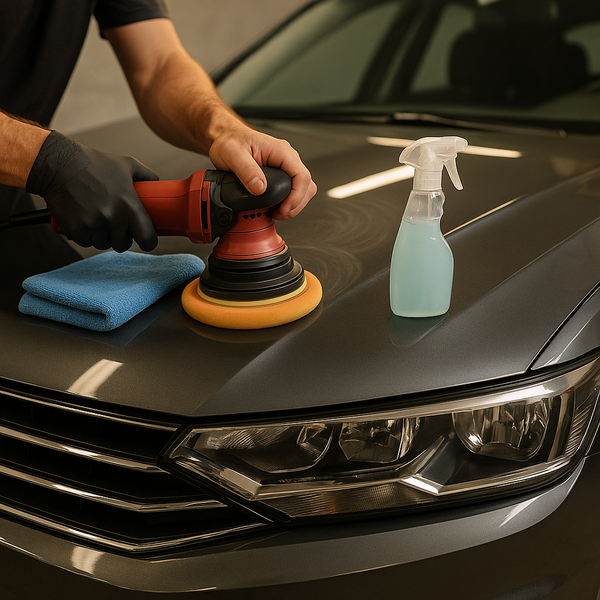
Giving your car a thorough clean isn't just about making it look good; it's about preserving its condition and value over time. Basic car detailing involves a set of simple, yet effective, steps you can perform yourself to keep your vehicle looking its best, inside and out. It goes beyond a quick wash, focusing on attention to detail that protects surfaces and provides a more enjoyable driving experience.
What is Basic Car Detailing?
Basic car detailing, often referred to as exterior and interior cleaning, focuses on the fundamental aspects of maintaining your vehicle's appearance and cleanliness. Unlike professional, multi-stage detailing which might involve paint correction, ceramic coatings, or extensive interior restoration, basic detailing is something readily achievable at home with common supplies. The goal is to remove dirt, grime, and minor contaminants from exterior surfaces and thoroughly clean and refresh the interior. This not only improves the car's aesthetics but also helps protect paint, upholstery, and plastic from premature wear and damage caused by accumulated dirt and UV exposure.
Gather Your Supplies
Before you begin, ensure you have all the necessary supplies. For exterior detailing, you'll need two buckets (one for wash solution, one for rinsing your wash mitt), a quality car wash soap, a wash mitt (microfiber or lamb's wool is recommended to prevent scratching), a separate brush for wheels and tires, a wheel cleaner, and several microfiber drying towels. For the interior, you'll need a vacuum cleaner with appropriate attachments, an all-purpose cleaner or interior detailer spray, microfiber cloths for wiping surfaces, a glass cleaner specifically for automotive windows, and possibly a small brush for vents and crevices. Having everything ready beforehand makes the process much smoother and more efficient.
Exterior Wash and Rinse
Start by rinsing the entire car thoroughly from top to bottom using a hose or pressure washer on a low setting. This removes loose dirt and grit that could scratch the paint during the washing process. Work in the shade whenever possible to prevent soap and water spots from drying on the paint. Use the two-bucket method: fill one bucket with your car wash soap solution and the other with clean water. Dip your wash mitt into the soap bucket, wash one section of the car at a time (working from top to bottom), and then rinse the mitt thoroughly in the clean water bucket before dipping it back into the soap. This significantly reduces the risk of dragging dirt particles across the paint. Rinse each section immediately after washing to prevent soap from drying. Pay special attention to lower panels which accumulate the most dirt.
Proper Drying Techniques
Drying is a crucial step to prevent water spots, which can be caused by minerals in the water drying on the paint. Using high-quality, absorbent microfiber drying towels is essential. Gently pat or lightly drag the towel across the surface; avoid rubbing vigorously, as this can cause scratches. Work from the top down. Some detailers prefer using a leaf blower or a dedicated car blower to force water out of crevices like mirrors, door handles, and body panel gaps before final drying with a towel. Ensure you dry all surfaces, including door jambs, trunk lid edges, and around the hood.
Interior Vacuuming
The interior often harbors more dirt and debris than we realize. Begin by removing all trash and personal items from the cabin. Use a vacuum cleaner with a crevice tool to reach tight spots like along the seat rails, between the center console and seats, and in door pockets. Switch to a brush attachment for carpets and floor mats to agitate dirt particles and make them easier to lift. Don't forget to vacuum under the seats and in the trunk. For heavily soiled floor mats, you may need to remove them from the car and clean them separately before vacuuming the floor underneath. Thorough vacuuming is key to a clean interior.
Cleaning Interior Surfaces and Glass
Dust and grime accumulate on dashboards, door panels, center consoles, and steering wheels. Use an interior cleaner or all-purpose cleaner (diluted if necessary according to product instructions) sprayed onto a microfiber cloth – never spray directly onto surfaces, especially near electronics. Gently wipe down all hard surfaces. For vents and tight areas, a small brush can help loosen dust before wiping. Clean interior glass using a dedicated automotive glass cleaner and a clean, lint-free microfiber cloth. Clean the inside of the windshield, side windows, rear window, and mirrors. For streak-free results, use two cloths: one to apply and wipe, and another clean, dry one for a final buff.
Optional: Simple Wax Application
For an extra layer of shine and protection, consider applying a basic spray wax or liquid wax after drying the exterior. Spray waxes are the easiest for beginners; simply mist onto a panel and wipe with a clean microfiber cloth, then buff with another clean cloth. Liquid waxes require a bit more effort, typically applied with a foam applicator pad in a thin, even layer and then buffed off once hazy. Wax adds a protective barrier against UV rays, environmental contaminants, and makes future washes easier. Always follow the product manufacturer's instructions for best results and application techniques.
Performing basic car detailing regularly is an investment in your vehicle's longevity and appearance. By following these steps, you can maintain that fresh look, protect your car from the elements, and enjoy a cleaner, more pleasant driving experience. It's a rewarding process that saves money compared to professional services while keeping your ride in top shape.

